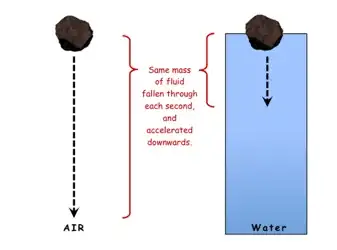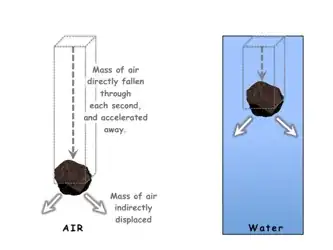I assume that you're asking a question about the fundamental physics involved in terminal velocity, then this is a good question.
Terminal velocity exists because at this point a falling object (e.g. rock) displaces a total mass of fluid (e.g. water or air) equal to their own mass, each second. This is similar to the concept of buoyancy for boats and balloons.
At terminal velocity:
Mass of Rock Falling = Total Mass of fluid displaced each second
which is the same as buoyancy for a boat floating in water:
Mass of Boat = Total Mass of fluid displaced each second
This is why the same object must fall a lot further through air than water, at terminal velocity for that fluid. i.e. The rock has to fall through a greater volume of air each second, before displacing the same total mass as compared to water, because air is a lot less dense than water (about 1/1000 times less dense). hence terminal velocity is a lot higher falling through air than water, as the rock falls further before achieving buoyancy. See image:

The 'total mass of fluid displaced' includes the fluid directly fallen through and the fluid indirectly displaced by the rock accelerating the fluid fallen through away from it.
Total mass of fluid displaced = Mass of fluid directly displaced + Mass of fluid indirectly displaced.

This approach allows you to calculate the downward force exerted by the rock on the air/water in terms of the mass of fluid ('m') fallen through and its acceleration ('a') i.e. Force = ma).
This is not how they explain it in school textbooks. They will blame things like viscosity of the fluid .... which is only part of the explanation. It misses the 'bigger picture' explanation of the masses involved.

